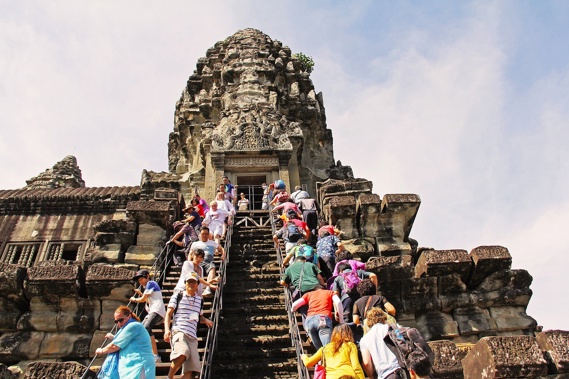
It’s been thirty years since the Angkor Archaeological Park was declared a World Heritage site. But amid the stash of temples and ornate structures prised out of the jungle, Angkor Wat is the most timeless anchor of wonder. On a previous visit to Angkor Wat, my Wendy Wu Tours guide looked visibly horrified when I went to swat a critter that landed on my nose. “It’s a butterfly!” I had assumed it was a more menacing buzzard, but his life-saving plea for mercy stopped me from taking abrupt action. The butterfly was a vivid black and green winged beauty, who gracefully fluttered away into the pale refuge of the temple’s interior. Yes, butterflies are sacred creatures in this spiritually-charged sanctuary. After all, Angkor Wat was rediscovered 150 years ago by a French naturalist, Henri Mouhot, while searching for butterflies.
Gazing in awe of one of the world’s most recognisable landmarks doesn’t require you to take in the sunrise after an ungodly wake-up call at 4am. It may be a tourist pastime, but chances are, if you have my luck, you’ll strike cloud and heaving throngs of tourists. Plan a visit to Angkor Wat in the early afternoon for a less-trafficked experience. That is one of the huge advantages of touring Angkor with Wendy Wu Tours. Their precision planning and in-the-know local expertise delivers a far more rewarding and effortless affair. The dimensions of the temple compound are staggering, covering an area of 1500 metres by 1300 metres.

Knowing where to go and what to see within this emblematic behemoth is rather handy. As the world’s largest religious monument, proudly emblazoned on the Cambodian flag, Angkor Wat was the spiritual centre of the Khmer empire, that lorded over the region from the 9th to the 15 centuries. The city of Angkor and its surrounding areas housed up to 1 million residents at its height in the 13th century, and at the time, it would have ranked as the largest city in the world. Dedicated to the Hindu god Vishnu and built in the 12th century by King Suryavarman II, and later transformed into a Buddhist temple, Angkor Wat’s colossal western entrance is flanked by balustrades of gigantic serpents which apparently represent cosmic fertility.
Admiring the five spires of the main temple, reaching over 65 metres in height, reflected in the waters of the pond is an indelible experience. Acclaimed for its intricate ornamentation, harmony and striking beauty, Angkor Wat symbolises the Hindu cosmos, with a temple mountain at its heart and the vast wrap-around moats representing the seven oceans that surround Mt. Meru, the mythical home of the Hindu gods. The five beehive-like spires form a giant lotus bud at the centre of the complex. Steep staircases will haul you up to the higher perches and incredible panoramas over the sheer immensity of Angkor Wat. Take it slowly in the heat of day!
The terraces are decorated with images of Hindu deities, many of which have sadly lost their heads to looters during the Khmer Rouge regime. But the artistry of the temple hits its zenith in the extensive bas-relief work that famously covers its walls. Don’t miss the first-level reliefs depicting the mythical "Churning of the Ocean of Milk," a legend in which Hindu deities stir vast oceans in order to extract the elixir of immortality. This churning produced the apsaras, Hindu celestial dancers. Roughly 2000 of them are liberally scattered throughout the temple.

Other reliefs surrounding the base of the main temple illustrate epic Khmer wars and an audience given by the king. If the architectural richness and grandeur sounds all a bit Tomb Raider – bingo - the 2001 blockbuster, featuring Angelina Jolie as Lara Croft, was filmed extensively here. Angkor Wat’s secrets continue to unfurl. Excavations and restoration of the jungle-enveloped city are still ongoing like an infinity labour of love. My guide remarked the German teams are the most meticulous restorers, while the Chinese and Indian crews are a little too “rough and ready.” New discoveries are being made using new technologies, such as radar imaging.
The scale of Angkor becomes larger and larger as excavation continues, and it is believed the ruins extend to some 1,000 sq km. Recent excavation work revealed wooden residences within Angkor Wat’s moat, believed to have been home to 3000 elites. Even after the king moved the capital city southwards to Phnom Penh in the mid-15th century, people continued to live there for over a century. Interestingly, one of the main reasons contributing to Angkor’s long decline was climate change.
While the Siamese-Khmer War in the late 15th century finally brought the empire to its knees, scans of tree rings reveal a devastating drought in the 14th century, which together with a series of heavy monsoons, impacted the city’s irrigation system. The Pyramids of Giza in Egypt were built to align with the three bright stars of Orion’s belt, while the arrangement of Angkor’s main temples corresponds to the stars in the Draco (dragon) constellation. Every spring and autumnal equinox at Angkor Wat is a major draw, as people flock to watch the sun magically rise exactly over the pinnacle of the temple’s central tower. It's a cosmic classic.

Where to stay? Ticking off the trove of temples at Angkor can sure tucker you out. What a joy it was to retire to my roost in Siem Reap, a legendary establishment in a league of its own. Introducing Raffles Grand Hotel d’Angkor, which was originally built as a rest stop for archaeologists and adventurers seeking to explore the ancient kingdom’s temples. Draped across 15 hectares of tenderly manicured grounds, this grand, opulent landmark hotel is a 2-minute walk from Angkor National Museum, and just ten minutes from the temples. Centrally located and directly across the road from the Royal Park, the hotel lovingly maintains this leafy expanse which pulses with locals exercising, early morning. Built in the French Colonial style popular in the early 20th century, be sure to take a ride in the historic lobby elevator, featuring ornate wrought iron doors.
Constructed in 1929, it actually pre-dates the rest of the hotel. Throughout this elegant sanctuary of calm, black-and-white marble floors and Khmer furnishings are to the fore. First opened in 1932, the hotel has been on the frontlines of global tourism’s ever-increasing love affair with Angkor. You’ll be royally treated by the ultra-attentive and unfailingly charming hotel staff. This grand dame has continued to play host to a roll call of leading lights, from Charlie Chaplin and Charles de Gaulle to Jacqueline Kennedy Onassis and Michelle Obama. Nods to history and cultural heritage are ever-present. The effervescent hotel doorman wears bell bottom-type trousers, in which the upper part of his trousers displays a different colour, depending which day of the week it is.

This is a charming tribute to how one of the old Khmer kings decreed how the days of the week should be illustrated, in their traditional attire of a silk sampot chang kben.(A lower-body wrap-around cloth – like a sarong.) After the sweaty exhaustion of hop-scotching between temple ruins, the sweet reward that punctuated my afternoons was the unadulterated state of bliss, wallowing in the soothing and restorative waters of the 35 metre long swimming pool – which just happens to
Cambodia’s biggest hotel pool. Inspired by Angkorian architecture, the pool’s dimensions are apparently a carbon copy of the king’s ancient royal at the Angkor complex. (Although unlike the original, the hotel didn’t have an adjoining ‘ladies pool’ for his 500 concubines.) Bracketed in fragrant frangipani trees, it’s a dreamy setting, underscoring the hotel’s ethos of emotional luxury.
Fresh from its 90th anniversary, nearly all of the hotel’s 119 guest rooms and suites have been fully refurbished in the restoration, with all-new Italian tiling and fixtures in the bathrooms. Accommodations feature classic luxury, including two-bedroom Villas which provide direct access to the garden and pool. I stayed in one of the four specially created Heritage Suites that take their inspiration from people who have been closely associated with Angkor. Each is fitted with a claw–foot bathtub, and a relaxing day bed on the oversized balcony which overlooks the majestic pool. I stayed in the Henri Marchal Suite - who was the Conservator of the Monuments of Angkor for many years.

All accommodations feature stylish furniture, exquisite Khmer art work and a whirl of creature comforts, including flat-screen TVs, free Wi-Fi, minibars, nespresso machines, and 24 hour room service. Foodies will be in seventh heaven, with a deliriously lavish array of buffet options greeting you in Café D’Angkor, as part of their famous Champagne Breakfast. One of Siem Reap’s most celebrated bars is the Elephant Bar, home to the delicious signature cocktail, Airavata. It’s an essential experience. This spectacular blend of rum, coconut passion, lime juice, crème de banana, pineapple and coconut juice is gorgeously presented in a ceramic jug moulded in the shape of an elephant’s head. Airvata takes its name from the mythical white elephant ridden by Indra, the Hindu King of Gods.
As the only hotel in Cambodia to carry the royal crest, expect big things from Restaurant 1932. Showcasing Royal Khmer and French cuisine, ancient Khmer recipes have been handed down over centuries by the chefs of the Royal Palace. When the King and his family stay in Siem Reap, the restaurant’s executive chef tends to their needs. You can expect a memorable gastronomic experience, bolstered by a wine cellar boasting over 400 wines from across the world.
It’s an incomparable opportunity to savour Cambodia’s national dishes, including Steamed Fish “Amok” with Mild Spices and Local Herbs in a Young Coconut Shell. Similarly, the menu features Loc Lac Wagyu Beef. Traditional Khmer cuisine is light and delicate, with intriguing textures, complex aromas and fresh exhilarating flavours. Reserve some stomach space to sample the Royal Khmer sweets. 1932 is a masterclass expression of culinary pride, and like every other aspect to this national treasure of a hotel, it will linger long and fondly in your Angkor memories. http://www.raffles.com/siem-reap/

Wendy Wu Tours offers a wealth of touring options in Cambodia, whether you’re looking for an extensive multi-day journey or private day-trip, threading together all of the essential sights with flexibility for personal exploration. The on-the-ground local expertise was exceptional. You’ll love the passion, informality and knowledgeable insights of your guides. Book a touring option that best suits your desires. www.wendywutours.co.nz
Mike Yardley is our resident traveller on Jack Tame Saturday Mornings.
Take your Radio, Podcasts and Music with you









